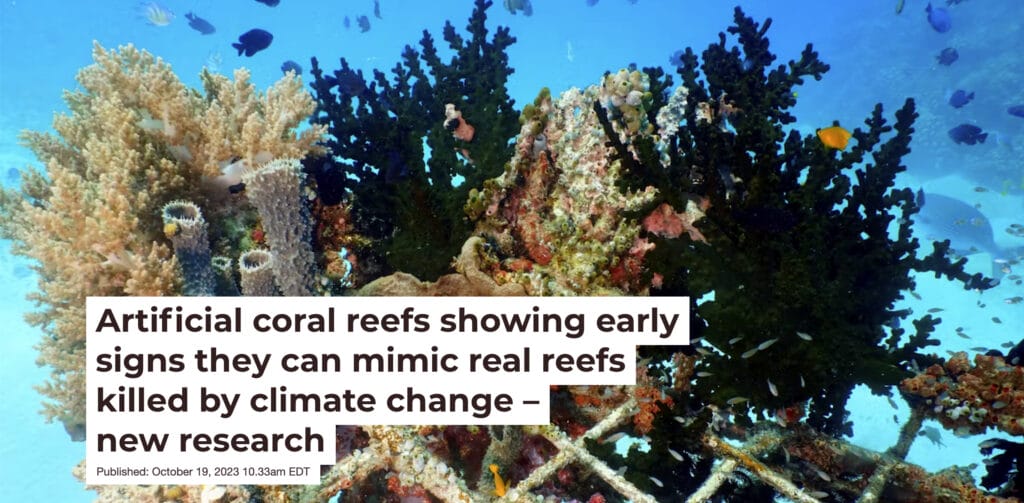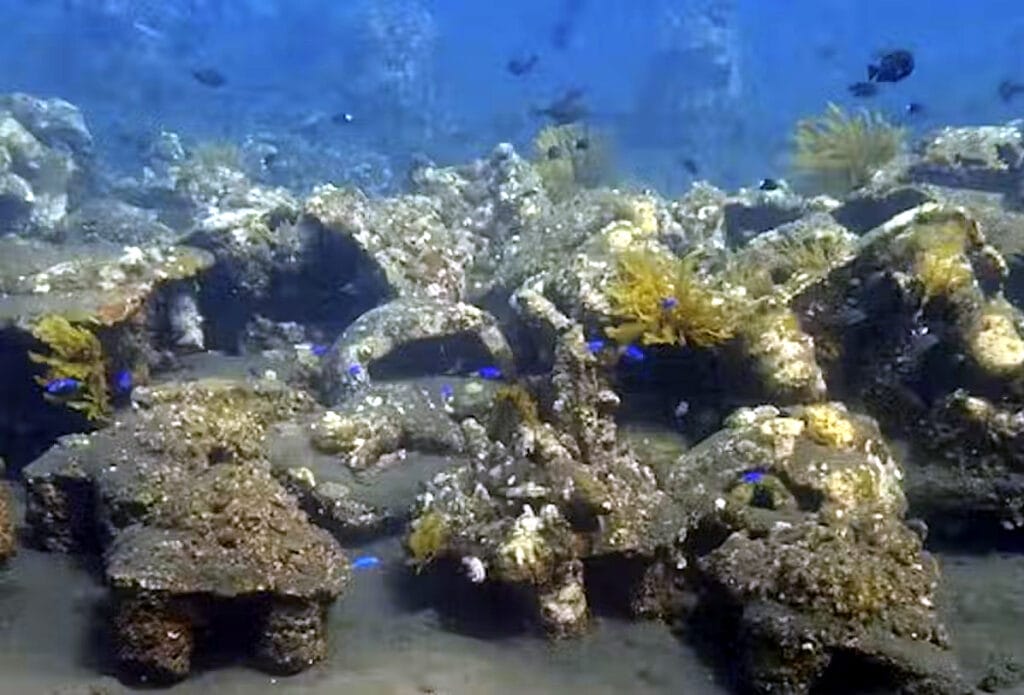REAL AND FAKE CORAL REEF RESTORATION (UPDATED)
by Tom Goreau | Oct 22, 2023 |

 BIOROCK coral reef (top), concrete artificial reef (bottom), North Bali.
BIOROCK coral reef (top), concrete artificial reef (bottom), North Bali.
The photographs above, from the original posted version of a recent article “Artificial coral reefs showing early signs they can mimic real reefs killed by climate change” (https://theconversation.com/artificial-coral-reefs-showing-early-signs-they-can-mimic-real-reefs-killed-by-climate-change-new-research-215011), unwittingly shows the difference between real and fake results through deceptive descriptions.
The Biorock reef at top, which is not identified, is 20 years old, and was built at the Karang Lestari Reef Restoration Project in Pemuteran, North Bali, by Komang Astika, Wolf Hilbertz, and myself, after the original coral reef suffered near total mortality from bleaching in the 1998 El Niño. It is covered with natural limestone rock grown from sea water by the Biorock Electric Reef Technology, on which a very wide diversity of hard reef-building corals, soft corals, sponges, and all other reef organisms have spontaneously settled on, or migrated to. Especially noticeable are large growths of the rare black/green coral, Tubastrea micrantha. The reef is packed with fish of many species.
The bottom concrete reef, also in North Bali, is largely smothered in grey mud, and the only organisms settling on it are vicious stinging yellow hydroids, without corals, sponges, or normal reef organisms. Tom Goreau has seen concrete in the water for more than 70 years and has never seen it turn into a real coral reef community: artificial materials may impress their designers, but they don’t attract real corals!
It is long known to marine ecologists that a distinctive reef ecosystem grows only on limestone rock, the natural material that reef ecosystems develop on, because almost all reef species are extremely selective and fussy about settling ONLY on clean limestone rock, and refuse to settle on exotic artificial materials like concrete, plastic, steel, rubber, and other marine garbage. These artificial materials are settled on only by a small group of opportunistic weedy species that spread over dead reefs but don’t build coral reef ecosystems, primarily stinging hydroids and slimy cyanobacteria and algae. Only very few weedy species of corals and barnacles will settle on concrete, steel, rubber, or plastic, and these are fouling organisms that do not build significant reef ecosystems. Steel shipwrecks can grow real coral reef communities, but ONLY if they have grown a limestone layer over the steel as the result of electrical currents flowing between different metals, a natural process Biorock Electric Reefs greatly accelerates.
Because the article does not identify the source of the photographs as Biorock reefs, it falsely implies that the results that ONLY Biorock Electric Reef Technology achieves (top image) can be reached with exotic materials like concrete, despite large-scale failure of “artificial reef” materials to achieve meaningful results (bottom image). This also applies to all “3-D printed artificial reefs” made from plastics, ceramics, or other un-natural materials that no self-respecting coral larva will settle on.
Huge amounts of money have been wasted on “artiifical reefs” made from concrete, plastic, steel, glued sand over steel, exotic ceramic mixtures, fishing line, and other coral-unfriendly materials. These reefs not only do not develop natural biodiverse coral ecosystems like Biorock does, they generate slimy stinging fouling communities dominated by hydroids instead. Corals transplanted on to them may grow temporarily when water quality conditions are good, but will all die whenever the water gets hot, muddy, polluted, rough, or when disease strikes. The current ongoing bleaching event will wipe out these well-intended, but fatally flawed, exotic “restoration” projects in the coming year.
UPDATE: When we pointed out to the publishers of the article that using an unidentified photograph of a Biorock reef to illustrate an article on concrete artificial reefs was misleading, the Editors immediately agreed, withdrew the original photograph, and replaced it with a photo of a red starfish on a concrete wall. The article as now published no longer contains the misidentified Biorock reef. However the point accidentally made by the original photos remains valid.
Photographs of Biorock reefs are often chosen by photo editors to illustrate articles about completely unrelated methods. This is because they pick the prettiest photo they can find, and the bright colors, high biomass, and high biodiversity of Biorock reefs are chosen rather than the dull results of the method actually being publicized in the article. Both The Economist and The Financial Times have used un-identified Biorock photographs to illustrate articles that do not achieve Biorock’s resuilts, creating false impressions through deceptive labelling. The Economist and The Financial Times both refused to acknowledge the dishonest and unethical use of Biorock photographs. We thank The Conversation for their commitment to the highest standards of journalistic integrity!
See: https://www.globalcoral.org/biorock-arks-save-corals-from-bleaching-when-fragmented-corals-die-of-heat-stroke/

 BIOROCK coral reef (top), concrete artificial reef (bottom), North Bali.
BIOROCK coral reef (top), concrete artificial reef (bottom), North Bali.